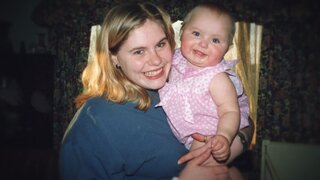Create a free profile to get unlimited access to exclusive videos, breaking news, sweepstakes, and more!
Days Before Testifying In Rape Trial, Young Mom And Her Baby Daughter Vanish — What Happened?
As investigators tried to determine who weighed Rachel Timmerman down with cinder blocks and threw her in a Michigan lake, they discovered multiple people connected to their main suspect had gone missing.
On July 5, 1997, two turtle hunters in Newaygo County, north of Grand Rapids, Michigan made a grim discovery: They found a woman’s decomposing body floating in a lake in a national forest.
“Duct tape had been placed around her head, which covered up her mouth and also covered up her eyes,” Curtis Schram, retired Det. F. Lt., Michigan State Police, told “Twisted Killers,” airing Thursdays at 9/8c on Oxygen. “Her nose was not covered with duct tape.”
Her hands were handcuffed behind her back. Chains wrapped around her torso were tethered to cinder blocks tinged with red paint. They were used to weigh down the body, which made its way to the surface due to gasses building up inside the body. The medical examiner determined the cause of death to be asphyxia by drowning.
“Our victim, in all likelihood, was alive when placed in the water,” said David Babcock, retired Undersheriff, Newaygo County Sheriff’s Office.
The victim was identified as 19-year-old Rachel Timmerman, who lived in Cedar Springs, about 20 miles from where she was recovered. She had an infant daughter, Shannon. Where was the baby? Investigators raced to locate Shannon.
Tim Timmerman, Rachel’s father, told investigators that his daughter had gone on a date on June 3 with a man named John. She had brought Shannon with her. When Rachel and the baby didn’t return that night, her dad was concerned, but the next day he received a letter from Rachel clearly in her handwriting telling him not to worry. She’d met her dream man, she’d written. Around June 10, another letter had arrived. She wrote that she and her daughter were starting a new life in Little Rock, Arkansas.
“It didn’t make any sense to us, but there was nothing we could do,” said Tim. “She was an adult.”
Local officials reached out to the FBI for help, as Rachel’s family helped officials create a composite sketch of the man who picked up Rachel.
Detectives dug into Rachel’s history and found that she’d reported being raped in August 1996. She had been playing cards with two men, Wayne Davis and Marvin Gabrion. She’d said that all three of them had gone out for beer, but Gabrion forced Davis out of the vehicle. He then drove Rachel to a wooded area, she’d said, and sexually assaulted her. If she told anyone, he said he would “kill Shannon and make her watch,” according to one of Rachel’s friends. Nonetheless, Rachel went to the police.
Davis’ version of the events up to the point where he got out of the car corroborated Rachel’s account. In January 1997, Gabrion was arrested, but a couple of weeks later, while awaiting trial, “he was bonded out by a friend of his,” said Schram.
Rachel was scheduled to testify in court against Gabrion on June 5. She was last seen two days before that. Gabrion appeared in court. Rachel did not.
“It sure looks like someone didn’t want her to testify,” said former NYC prosecutor Beth Karas.
Gabrion, who was nowhere to be found, became the prime murder suspect.
Investigators searched Gabrion’s residence in Altona, Michigan. They found duct tape like the kind found on Rachel’s body as well as red-tinged cinder blocks. His neighbors also told investigators they were afraid of Gabrion because of his scary behavior.
“He was a one-man crime wave in that area,” said Timothy Verhey, Assistant U.S. Attorney.
Police went to speak with Davis, but discovered that he, too, had disappeared. A friend of his told authorities that she hadn’t seen him in some time. Had Davis, a witness to Rachel’s rape, left on his own — or against his will? It was unclear.
“Within a period of two weeks, there were three people missing or dead,” reflected Roberta Gilligan, retired Special Agent, FBI.
In August 1997, a call to the Michigan State Police tip line provided the break investigators needed. The girlfriend of a man named John Weeks said that she’d overheard him having a phone conversation with Rachel Timmerman. Weeks told her that he’d made the calls on behalf of a friend — Marvin Gabrion, she believed. Weeks was a strong match for the composite sketch of the man in the car with Rachel. Weeks’ girlfriend hadn’t seen him since the end of June.
Police spoke with campers who identified Weeks and Gabrion through photos as men they encountered at Oxford Lake in early June 1997. A woman was with them who looked like Rachel, the witnesses said.
As the number of people connected with Gabrion who’d vanished rose, officials considered that they could be hunting for a serial killer.
Gabrion “was different from most serial killers in that he had a very clear motive,” said Dr. Kate Termini, a forensic psychologist. “He killed out of pure necessity for self preservation. He was trying to protect himself against people that could have identified him.”
Investigators focused on Gabrion’s phone and bank records to track him down. They learned that he used the alias Robert Allen, which was the same name as a disabled Grand Rapids man who collected Social Security. Allen’s family hadn’t seen him since late 1995, but his Social Security checks were still being cashed. Those checks were being sent to a post office box in Sherman, New York, outside Buffalo.
Detectives determined that the next check would be available on October 14. An FBI task force covertly waited for Gabrion to arrive to pick up the check, and when he did, Gabrion was arrested and brought back to Michigan.
He denied any guilt and claimed that someone else had Rachel and her baby killed.
“He was very uncooperative,” said Gilligan. “At times he would try to be charming, but it was unnerving to be around him. He did seem evil.”
Investigators believed that taking the baby was a way to control Rachel and force her to write letters to her family. Shannon's body was never found.
“We believe Marvin Gabriel could not allow baby Shannon to live because she linked Gabrion to the murder,” said Verhey.
Authorities believe that in addition to the mother and daughter, Gabrion killed Robert Allen, Wayne Davis, and John Weeks.
Because only a single body was recovered, Gabrion was charged with one count of murder. His trial began in 2002, and Gabrion was found guilty. Because the lake where Rachel was killed is on federal property, it allowed prosecution under federal law — and the death penalty, mlive.com reported. The jury sentenced Gabrion to death, the Associated Press reported.
A couple of months after the conviction, Davis’ body was found in a Newaygo County pond.
To learn more about the case, watch “Twisted Killers,” airing Thursdays at 9/8c on Oxygen, and stream episodes here.






















